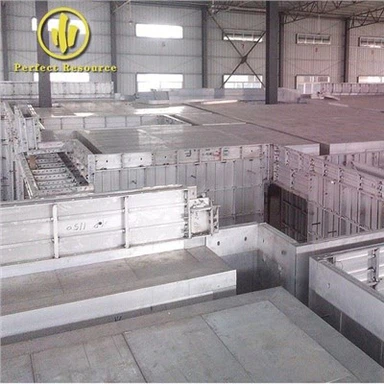Why is aluminum formwork considered the backbone of high-rise buildings
Oct 09, 2024
Aluminum formwork is a building formwork made of aluminum alloy, also known as aluminum alloy formwork. It refers to a universal accessory composed of three parts: aluminum panels, brackets, and connectors. It is designed according to the module and extruded by specialized equipment. It can be combined and assembled into complex overall formwork of different sizes. The system formwork for assembly and industrial construction solves the shortcomings of traditional formwork and greatly improves construction efficiency. More than ten policies have been released nationwide to promote aluminum templates.
Is aluminum formwork the "backbone" of high-rise buildings?
1, The advantages of using aluminum formwork technology in high-rise buildings
1. Aluminum formwork technology does not require the assistance of mechanical equipment during construction, only manual splicing and installation of aluminum formwork is needed, reflecting the convenient operation characteristics.
2. Aluminum formwork has strong load-bearing capacity and can withstand more pressure compared to ordinary formwork, providing a guarantee for the stability of the building and reducing the occurrence of safety hazards during construction.
3. Aluminum formwork has a wide range of applications, and its construction is not limited by many conditions. After splicing, the gaps at the joints are small and the application rate is high. It is not easy to produce waste materials, making the construction environment clean. At the same time, it has the simplicity and resistance to damage of dismantling work, and can be reused again.
The comprehensive benefits of aluminum formwork
1. In terms of technology, the use of 3D technology can transform traditional 2D flat drawings of buildings and structures into 3D models, visually express and communicate, detect design errors in advance, and reduce unnecessary changes and rework.
2. In terms of progress: using aluminum molds for 3 days per layer and wooden molds for 5-6 days per layer, the progress is faster and the cost is effectively controlled.
3. In terms of management, the use of aluminum molds reduces the number of management personnel by half compared to traditional templates, and the process management is simpler and less procedural than traditional wooden molds, promoting scientific construction and refined management.
4. In terms of quality, the top plate is flat, the corners are square, the walls are vertical, and the beams are straight, all of which can meet the relevant quality standards and there will be no mold bursting phenomenon.
5. In terms of safety, the vertical transportation of the upper and lower layer transfer templates has minimal safety hazards, and avoids safety risks during the use of unloading platforms, reducing the safety risks of tower crane transportation of materials.
6. In terms of civilized construction, the use of aluminum molds for demoulding has been completed, resulting in less construction waste and easy floor cleaning. Civilized construction meets standards and responds to environmental protection and resource conservation.
7. Indirect costs: The rental and management costs of auxiliary materials and machinery are correspondingly reduced, thereby improving economic efficiency.
The materials used in traditional formwork construction are usually disposable, which does not conform to the modern concept of resource conservation and also increases the cost expenditure. Compared with traditional construction, aluminum formwork technology has the characteristic of being reusable, which fundamentally saves resources and can be applied in high-rise buildings. It can even play its role in complex environment construction. Aluminum formwork construction technology can effectively improve construction efficiency, ensure construction quality, enhance the accuracy of building projects and its environmentally friendly characteristics, play its role in buildings, and ensure the standards and quality of building projects.
Advantages of Aluminum Template
1. Long service life, the average service life of aluminum alloy templates can reach 300-500 times or more.
2. All structures are assembled using aluminum alloy templates, and after assembly, they form a complete frame with good stability and high bearing capacity.
3. The top formwork and support system have achieved integrated design, integrating early dismantling technology into the top slab support system, greatly improving the turnover rate of the formwork.
4. Aluminum formwork support rods are relatively few, providing large on-site operating space, smooth personnel flow, and convenient material handling, greatly improving on-site management efficiency.
5. After the removal of the aluminum alloy formwork system, the surface quality of the concrete is smooth and polished, achieving the effect of finished plain concrete.
6. Widely applicable, suitable for building residential buildings, infrastructure, water channels and tunnels, etc.
You Might Also Like
-

Assembled Monolithic Structure Concrete Formwork For Cons...
-

Hot Sale Aluminum Concrete Molds With Longitudinal Stiffener
-

Aluminum Shuttering Formwork System For Concrete Casting
-

Lower Cost High Efficiency Geopanel Prefabricated Formwor...
-

Fast Construction Concrete Aluminium Panel Slab Formwork ...
-

Struture Decking Concrete Slab

